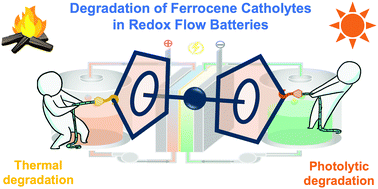Mechanistic insights of cycling stability of ferrocene catholytes in aqueous redox flow batteries†
Abstract
Water soluble ferrocene (Fc) derivatives are promising cathode materials for aqueous organic redox flow batteries (AORFBs) towards scalable energy storage. However, their structure–performance relationship and degradation mechanism in aqueous electrolytes remain unclear. Herein, physicochemical and electrochemical properties, battery performance, and degradation mechanisms of three Fc catholytes, (ferrocenylmethyl)trimethylammonium chloride (C1-FcNCl), (2-ferrocenyl-ethyl)trimethylammonium chloride (C2-FcNCl), and (3-ferrocenyl-propyl)trimethylammonium chloride (C3-FcNCl) in pH neutral aqueous electrolytes were systemically investigated. UV-Vis and gas chromatography (GC) studies confirmed the thermal and photolytic Cx-Cp− ligand dissociation decomposition pathways of both discharged and charged states of C1-FcNCl and C2-FcNCl catholytes. In contrast, in the case of the C3-FcNCl catholyte, the electron-donating 3-(trimethylammonium)propyl group strengthens the coordination between the C3-Cp− ligand and the Fe3+ or Fe2+ center and thus mitigates the ligand-dissociation degradation. Consistently, the Fc electrolytes displayed cycling stability in both half-cell and full-cell flow batteries in the order of C1-FcNCl < C2-FcNCl < C3-FcNCl.



 Please wait while we load your content...
Please wait while we load your content...
